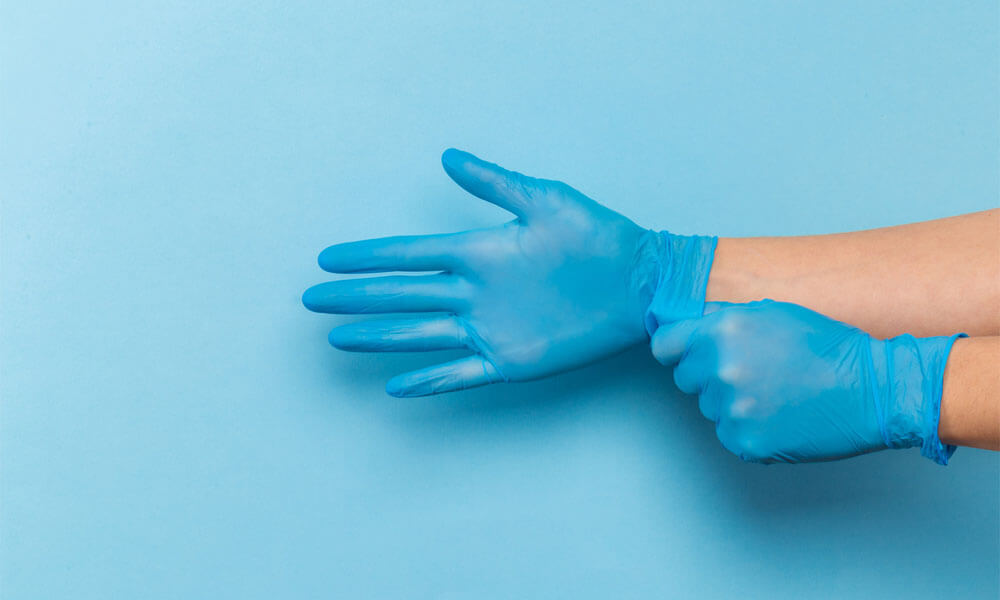Protect yourself and others
Using the right gloves reduces the transmission of microorganisms. Especially in the current circumstances due to COVID-19, personal protective equipment is a must for good hygiene. Disposable gloves are widely used in many sectors, such as the medical sector, industry and hospitality.
What gloves do you need?
The gloves you need exactly depend on your situation and work. There are various types of gloves, from simple disposable gloves that you use at a gas station to disposable gloves that are used for food preparation, cleaning or contact professions.
Most disposable gloves are made of latex, vinyl or nitrile and come in a variety of sizes and colours. Nitrile and latex gloves are very popular in the medical sector, food industry and research laboratories. Vinyl gloves are the least strong gloves of the three and therefore also the cheapest.
Due to HACCP guidelines, blue gloves are used in the food industry. This colour is easily traceable in a product, should a glove be lost. In addition, it can be useful for a company to work with different coloured gloves. This way, they can indicate which activities are performed with which colour glove.
Not only does a choice need to be made between the different types of materials that a disposable glove can be made of, a choice also needs to be made between unpowdered or powdered gloves. Powdered gloves have a layer of corn starch on the inside. This absorbs moisture and makes putting on the glove easier. However, powdered gloves are not ideal in every work environment, such as the food industry. They are not permitted here because the powder can end up in the food. Gloves are produced with powder as standard. This is why unpowdered gloves are often more expensive than powdered gloves. The powder has to be removed.
What is the difference between vinyl, latex and nitrile disposable gloves?
It is important to know in advance what the requirements are for a disposable glove. In which sector will they be used and against which substances should they offer protection?
Latex
Latex gloves are made of natural rubber. A very suitable material for gloves for medical applications, laboratories and the food industry. They are strong and elastic, but the major disadvantage is the presence of proteins in this material. This can cause users to have allergic reactions. Latex is also not suitable for use in combination with fats and oil, this affects the glove.
A disadvantage of these gloves is that holes are masked by the elasticity of these gloves. This can of course have consequences for people who work with chemicals or micro-organisms.
✓ Strong
✓ Good fit
✓ Very elastic
✓ Are not manufactured using chemical processes, so less harmful to the environment
Nitril
Nitrile gloves are made of synthetic rubber and are therefore allergy-free. In short, an excellent alternative to latex gloves. They are available in multiple colours and the strength and resistance to chemicals is excellent. Nitrile is also resistant to fats and oils and also to nitrogen, ketones and oxidising acids. Nitrile gloves are popular in the medical sector, research laboratories and in the food industry.
✓ Longer lifespan than latex gloves
✓ Good fit
✓ Very elastic
✓ Good grip
✓ Alternative for people with latex allergies
Vinyl
Vinyl gloves are the thinnest and cheapest gloves. This also makes them the least resistant to chemical stress and perforation. When working with hazardous substances within a company, it is better not to choose vinyl. Vinyl gloves are suitable when gloves need to be changed frequently, for example when the gloves are worn to promote food hygiene or to protect the hands from dirt. These gloves are also an alternative for people with a latex allergy. They are resistant to fats and oils, but not to ketones and solvents.
✓ Inexpensive
✓ Ideal when gloves need to be changed frequently
✓ Alternative for people with latex allergies
Helpful tips
✓ Disposable gloves are for single use
✓ Do not wear anything under the glove (rings, watches, etc.) to prevent perforations and tears.
✓ Latex allergy? Use the vinyl or nitrile variant
✓ Choose nitrile gloves for long-term use
✓ Take off the used gloves correctly for good hygiene
Want to know more about good protection and hygiene with disposable gloves?
The use of the right disposable gloves depends on the application. Our advice is to continue investing in personal protective equipment (PPE). Nitrile gloves, for example, are somewhat more expensive than the latex and vinyl variants, but they do offer the most optimal protection. All disposable gloves are packaged in boxes of 100.
Need more information? Feel free to contact us for a no-obligation consultation. Our team will be happy to help you. Or sign up for our free newsletter for useful information about our protective equipment and other products in the field of company emergency response, evacuation and first aid.

